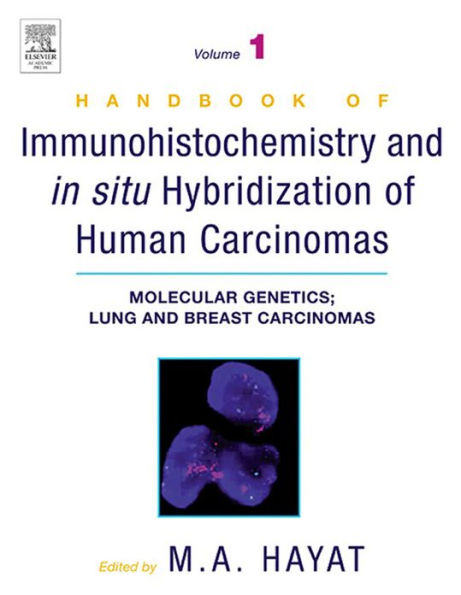
Handbook of Immunohistochemistry and in Situ Hybridization of Human Carcinomas: Molecular Genetics; Lung and Breast Carcinomas
556
Handbook of Immunohistochemistry and in Situ Hybridization of Human Carcinomas: Molecular Genetics; Lung and Breast Carcinomas
556eBook
Available on Compatible NOOK devices, the free NOOK App and in My Digital Library.
Related collections and offers
Overview
The various cell types have traditionally been recognized and classified according to their appearance in the light microscope following the process of fixing, processing, sectioning, and staining tissues that is known as histology. Classical histology has been augmented by immunohistochemistry (the use of specific antibodies to stain particular molecular species in situ). Immunohistochemistry has allowed the identification of many more cell types than could be visualized by classical histology, particularly in the immune system and among the scattered hormone-secreting cells of the endocrine system.
Handbook of Immunohistochemistry and in Situ Hybridization of Human Carcinomas discusses all aspects of immunohistochemistry and in situ hybridization technologies and the important role they play in reaching a cancer diagnosis. It provides step-by-step instructions on the methods of additional molecular technologies such as DNA microarrays, and microdissection, along with the benefits and limitations of each method. The topics of region-specific gene expression, its role in cancer development and the techniques that assist in the understanding of the molecular basis of disease are relevant and necessary in science today, ensuring a wide audience for this book.
- The only book available that translates molecular genetics into cancer diagnosis
- Provides the readers with tools necessary to perform and optimize sensitive, powerful techniques, including immunohistochemistry and fluorescence in situ hybridization, used in tumor diagnosis
- Written by experts in this field, the book provides theoretical considerations as well as practical approaches to carry out effectively these techniques
- Offers suggestions, tips, cautions, and guidelines to avoid artifacts and misdiagnosis
- Introduces new techniques to detect genes and proteins involved in the initiation and progression of cancer
- Covers the latest developments and a wide range of applications to the detection of antigens and single-copy DNA and RNA
- Written in a uniform format, each chapter includes Introduction, Materials required, step-by-step detailed Methods, Results, Discussion, and comprehensive up-to-date References

Product Details
| ISBN-13: | 9780080495194 |
|---|---|
| Publisher: | Elsevier Science |
| Publication date: | 06/16/2004 |
| Sold by: | Barnes & Noble |
| Format: | eBook |
| Pages: | 556 |
| File size: | 25 MB |
| Note: | This product may take a few minutes to download. |
About the Author
Table of Contents
Comparison of Immunohistochemistry, in Situ Hybridization, Fluorescence in situ Hybridization, and Chromogenic in situ HybridizationComparison of Chromogenic in situ Hybridization, Fluorescence in situ Hybridization and Immunohistochemistry
Target and Signal Amplification to Increase the Sensitivity of in situ Hybridization
Polymerase Chain Reaction
DNA Microarrays Technology
Tissue Microarrays and their Modifications in Highthoroughput Analysis of Clinical Specimens
Gene Expression Profiling Using Laser Microdissection in Cancer Tissues
Differential Display of Gene Expression in Human Carcinomas
Serial Analysis of Gene Expression in Human Diseases
Lung Carcinoma: An Introduction
Hitopathological Classification and Phenotype of Lung Tumors
Immunohistochemistry and in situ Hybridization of Mucin in Lung Carcinoma
Immunohistochemical Expression of MDM2 in Lung Cancer
Immunohistochemical Expression of E2F1 and p14ARF in Lung Carcinoma
Role of Immunohistochemical Expression of Beta-Catenin in Lung Carcinoma
Immunohistochemistry of Laminin-5 in Lung Carcinoma
Role of Immunohistochemical Expression of Caveolin-1 in Lung Carcinoma
Role of Thyroid Transcription Factor-1 in Pulmonary Adenocarcinoma
Immunohistochemical and Molecular Pathology of Angiogenesis in Primary Lung Adenocarcinoma
Immunohistochemistry of Human Leukocyte Antigen Expression in Lung Carcinoma
In Situ Hybridization and Immunohistochemistry of Telomerase in Lung Carcinoma
Use of Fluorescence in situ Hybridization in Detection of Lung Cancer Cells
Immunohistochemistry of BCL-2 Gene Expression in Lung Carcinoma
Breast Carcinoma: An Introduction
Expression of Vascular Endothelial Growth Factor Receptor-2/Flk-1/KDR in Breast Carcinoma
HER2/Neu Amplification and Protein Overexpression in Breast Carcinoma: Immunohistochemistry and Fluorescence in situ Hybridization
Her-2/neu Amplification Detected by Fluorescence in situ Hybridization in Cytological Samples from Breast Cancer
Detection of HER-2 Oncogene with Chromogenic in situ Hybridization in Breast Carcinoma
Immunohistochemical Evaluation of Sentinel Lymph Nodes in Breast Carcinoma Patients
CD10 Expression in Normal Breast and Breast Cancer Tissue
Role of Immunohistochemical Expression of AKT Protein in Breast Carcinoma
Role of Immunohistochemical Expression of AKT Protein in Breast Carcinoma
Immunohistochemistry of Adhesion Moleculae Ceacam1 Expression in Breast Carcinoma
Role of Cadherins in Breast Cancer
Immunohistochemical Expression of Erythropoitein and Erythropoitin Receptor in Breast Carcinoma
Loss of BRCA1 Expression in Breast Carcinoma
Role of Immunohistochemical Expression of BRCA1 in Breast Cancer
Fluorescence in situ Hybridization of BRCA1 Gene in Breast Carcinoma
Immunohistochemistry of C-MYC Expression in Breast Carcinoma
Immunohistochemical Localization of Neuropilin-1 in Human Breast Carcinoma: A Possible Molecular Marker for Diagnosis
Role of the Epidermal Growth Factor Receptor in Breast Carcinoma
Alterations of the Cell Cycle Regulating Proteins in Invasive Breast Cancer
Correlation with Proliferation, Apoptosis, and Clinical Outcome
Immunohistochemistry of Estrogen Receptor Expression in Breast Carcinoma
Immunofluorescence and Immunohistochemical Localization of Progesterone Receptors in Breast Carcinoma
Immunohistochemical Expression of Cytosolic Thymidine Kinase in Patients with Breast Carcinoma
Immunohistochemical Detection of Melanoma Antigen E (MAGE) Expression in Breast Carcinoma
Role of Immunohistochemical Expression of Receptors in Male Breast Carcinoma
Detection of Glycoconjugates in Breast Cancer Cell Lines: Confocal Fluorescence
Role of ETV6-NTRK3 Gene Fusion in Breast Carcinoma
Role of CA6 Protein Expression in Breast Carcinoma
Immunohistochemistry of Effusions
Immunohistochemistry of Needle Cytopunctures of Breast Carcinomas
What People are Saying About This
Presents the latest in in situ hybridization and immunohistochemistry techniques expected to become an important part of cancer diagnosis in clinical practice in the future.
